The age-specific incidence of herpes zoster in the United States has been increasing in adults over age 65 even before implementation of the childhood varicella vaccination program, results from a retrospective study of Medicare data claims showed.
"Concern has been expressed that routine childhood varicella vaccination, introduced in the United States in 1996, could thereby lead to an increase in herpes zoster incidence by reducing opportunities for exposure to varicella," researchers led by Dr. Craig M. Hales reported. "Our findings suggest that, although herpes zoster incidence has increased in elderly persons, routine varicella vaccination has not influenced this increase." They characterized the information as "reassuring for countries considering universal varicella vaccination."
Medicare claims data from 1992 through 2010 were examined to evaluate trends in herpes zoster incidence in people older than age 65 and to determine any influence of the varicella vaccination program on these trends (Ann. Intern. Med. 2013;159:739-45). The investigators, from the National Center for Immunization and Respiratory Diseases at the Centers for Disease Control and Prevention, also examined the influence of age, gender, and race or ethnicity on herpes zoster incidence, which was defined as first occurrence of the condition in a given year in any health care setting according to International Classification of Diseases, Ninth Revision, Clinical Modification code.
From 1992 through 2010, a total of 281,317 cases of herpes zoster occurred among 2,845,353 Medicare beneficiaries. Their mean age was 76 years in 1992 and 77 years in 2010. After standardizing for age and gender, Dr. Hales and his associates found that herpes zoster incidence increased 39% from 10 per 1,000 person-years in 1992 to 13.9 per 1,000 person-years in 2010, but they did not detect evidence of a statistically significant change in the rate of increase after introduction of the varicella vaccination program in 1996.
From 1992 to 1996, the herpes zoster incidence was higher in women than in men (risk ratio, 1.21), and was lower in black and Hispanic people than in white people (RR, 0.51 and 0.76, respectively). In a model adjusted for gender, age, and calendar year from 1997 to 2010, the herpes zoster incidence did not vary by state varicella vaccination coverage (RR, 0.9998).
The researchers concluded that the study findings have several implications, including the fact that "in the absence of explanations for increasing herpes zoster incidence, properly monitoring the effect of the herpes zoster vaccination program or projecting future herpes zoster incidence will be difficult," they wrote. "Furthermore, herpes zoster poses a substantial burden of disease in the elderly population; continued increases in herpes zoster incidence would be worrisome and need to be understood."
The researchers stated that they had no relevant financial conflicts to disclose.


